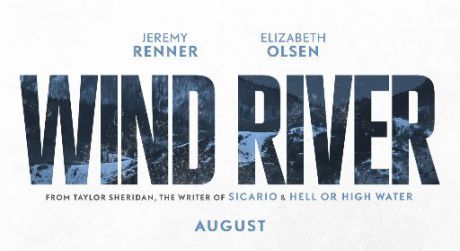Arts
You are here
Review: Wind River

September 10, 2017
First the good things about Taylor Sheridan's new movie "Wind River", which he directs and for which he wrote the screenplay. Sheridan was the writer of last year's brilliantly bleak truth-telling film about the dispossessed in Texas in the aftermath of the financial meltdown of 2008, "Hell or High Water."
His new movie is set on the Wind River reservation in Wyoming. The Wind River reservation was established for the Eastern Shoshone in 1868 and is now home to both the Shoshone and the Arapaho tribes. Sheridan describes it as one of the poorest reservations in North America.
The movie opens with the striking image of a young Indigenous woman running in the snow barefoot, obviously being pursued by persons unknown. The bleak beauty of this landscape is one that Sheridan knows intimately and he brings it memorably to the screen; he has talked in interviews about his connections and friendships with people living at Wind River.
These connections explain the care Sheridan has taken with the casting of his film: “I wasn’t going to sit here and tell a story about very real issues [including violence against Indigenous women] and cast people to portray characters in that world suffering those burdens and not have some connection.” There are some fine performances by Indigenous actors, including Graham Greene, Tantoo Cardinal and Gil Birmingham, a Comanche actor who plays the grieving father. Birmingham also appeared in "Hell or High Water" as a half-Comanche, half-Mexican Texas Ranger, playing Jeff Bridges' partner to great effect.
Colonial
“Wind River” involved Indigenous collaboration on many levels. Leaders from the Wind River Nations — the Eastern Shoshone and Northern Arapaho — read the script and visited the set. The Tunica-Biloxi tribe of Louisiana provided 90 percent of the film’s budget, with money allocated solely for the telling of Native American stories.
But Sheridan chooses to put at the centre of his movie about the harshness of life on the reserve two white characters: Jeremy Renner who plays Corey Lambert, a federal wildlife officer and tracker who finds the corpse of the young Indigenous woman we see fleeing at the beginning of the film, and Elizabeth Olsen, who plays the young, inexperienced FBI officer, Jane Banner, who comes onto the reserve, since homicide on reserve is deemed a federal crime.
There is much about jurisdiction of the various police who become involved in the case. It becomes clear that the Indigenous law enforcement officers, although they have the most knowledge about their own community and would presumably know the best way to proceed, are sidelined by the whole colonial set-up of control and contain.
Sheridan is not unaware of the irony. When Jane makes a request for FBI backup, realizing she is out of her depth, Graham Greene, playing the Indigenous police chief, schools her in the reality of life on reserve: "This isn't the land of backup, Jane. This is the land of 'you're on your own.'"
Jane requests Corey's help because she begins to realize that knowledge of the land and the people will be far more important in bringing the murderer to justice than any so-called 'investigative' skills. Corey is someone who has intimate ties to Wind River, both through his job as a tracker and his family connections. His ex-wife, their son and his wife's relatives are all on the reserve. His best friend Martin (Gil Birmingham) is the man whose daughter Natalie is found murdered at the beginning of the film. The bond between the two men is undeniably there. Corey's daughter Emily (best friends with Natalie) was found in similar inexplicable circumstances, dead from exposure miles from her home, three years earlier.
The scenes between Corey and Martin are some of the most moving in the film. As Sheridan describes Wind River one of the things it's clearly about is a father trying to move beyond a failure and a tragedy to the other side. As a director Sheridan knows how to elicit excellent performances from his actors. Renner is the best he's ever been in this mostly non-verbal role where much of the meaning comes through the pain and empathy in his eyes. And Birmingham as a man who is confronted with the reality of his daughter's brutal rape and murder couldn't be better.
Elizabeth Olsen is also good as the green FBI agent who toughens up through coming to realize what she's up against how and how unprepared she is for dealing with the real lives of the people she's investigating. There's a powerful scene where she goes to visit Martin and his wife to ask about their daughter and comes face up against their indescribable grief, which can't be assuaged by any meaningless official phrases.
And, although Corey definitely has deep ties to the Indigenous people of Wind River and to the land that he knows like the back of his hand, the filmmaker is not unaware of the seemingly unbridgeable distance between his experience and that of the people who were forced to accept this land of 'cold and snow' as their own by the colonizers.
Cory is trying to console Chip (Martin Sensmeier) when he learns that his sister Natalie has been murdered. Cory tries to include himself as one of the tribe but Chip retorts, “Only thing Native about you is your ex-wife and a daughter you couldn’t protect.”
There is much to like and respect about this film: the harsh beauty of the winter landscape, the great pacing and tension of a traditional thriller, the gritty and realistic portrayal of life on the reserve and the way it shapes character, the spotlight it shines on the violence perpetrated on Indigenous women. However, it is much to be hoped that we will have the chance to see mainstream films in the future where Indigenous writers, actors & directors can tell their own stories and be at the centre of these stories.
Section:
Topics:










